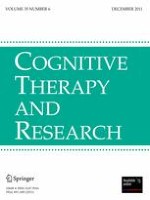01-12-2011 | Brief Report
Do Extreme Beliefs About Internal States Predict Mood Swings in an Analogue Sample?
Gepubliceerd in: Cognitive Therapy and Research | Uitgave 6/2011
Log in om toegang te krijgenAbstract
An integrative cognitive model (Mansell et al. in Behav Cogn Psychother 35(5):515–539, 2007) proposed that multiple, extreme, personalised beliefs about internal states are key to the development and maintenance of mood swings and bipolar disorders. These beliefs can be assessed by the Hypomanic Attitudes & Positive Predictions Inventory (HAPPI; Mansell in Behav Cogn Psychother 34:467–476, 2006). In a student sample (N = 175), the HAPPI independently predicted bipolar-relevant mood states and hypomania-relevant behaviours over a 4-day period. In line with previous research, the Hypomanic Personality Scale (HYP; Eckblad and Chapman in J Abnorm Psychol 95(3):214–222, 1986) and subscales of the Behavioural Inhibition and Behavioural Activation Scales (BIS/BAS; Carver and White in J Pers Soc Psychol 67(2):319–333, 1994) showed independent associations with outcome variables. The findings are discussed in the context of Mansell et al’s (Behav Cogn Psychother 35(5):515–539, 2007) model.
